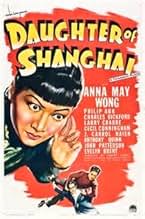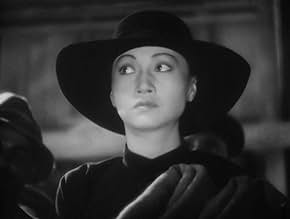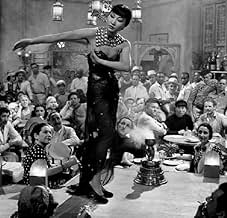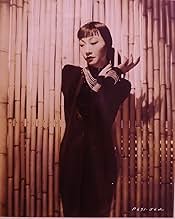NOTE IMDb
6,6/10
654
MA NOTE
Une femme sino-américaine tente de dénoncer un réseau de trafic d'étrangers illégaux.Une femme sino-américaine tente de dénoncer un réseau de trafic d'étrangers illégaux.Une femme sino-américaine tente de dénoncer un réseau de trafic d'étrangers illégaux.
- Réalisation
- Scénario
- Casting principal
- Récompenses
- 1 victoire au total
Buster Crabbe
- Andrew Sleete
- (as Larry Crabbe)
Paulita Arvizu
- Dancer
- (non crédité)
Carmen Bailey
- Dancer
- (non crédité)
Ted Billings
- Barfly
- (non crédité)
Agostino Borgato
- Gypsy
- (non crédité)
Marie Burton
- Girl
- (non crédité)
Avis à la une
The great Anna May Wong stars as a Chinese girl who is trying to track down her fathers killers after he is rubbed out for trying to stop the flow of illegal aliens. Wong the only Chinese American to star in films in the 1920's and 1930's. She exudes sensuality and was a damn fine actress to boot. Here she does it all as she goes from San Fransico to South America in trying to reveal the head of the smuggling ring. Its gritty and nasty in surprising ways especially for a code production. The smoldering sexuality of the dive in South America seems to have come from the gritty films of the late 1940's or the precode films of the 1930s. Frankly this is a lost treasure. This is a movie that is perfectly paced to keep you watching with twist and turn and odd twist. Only when a Deus ex Machina shows up towards the end that it shows its programmer heritage. The cast is a who's who of mid-level stars to be in Buster Crabbe, Charles Bickford, J Carol Nash and some Irishman named Anthony Quinn. This is 63 minutes of pure enjoyment. I can't recommend this enough, and while it ain't the best of the best, its near that.
Anna May Wong's father is killed because he will not cooperate with a gang that smuggles illegal Chinese emigrants into the US. Miss Wong goes undercover to help Federal agent Philip Ahn track down the mysterious head of the ring.
Paramount gave Miss Wong a push upward with top billing on this B movie directed by Robert Florey. She's certainly given a splashy entrance in a spectacular Chinese costume, but despite popping in and out as she goes dance hall girl somewhere in the islands back to the US, the story is diffuse. Intercut with her, we see Ahn's slow track dealing with slow-witted goons, and a large cast of performers adding attraction to the story: Charles Bickford, Buster Crabbe, Cecil Cunningham, J. Carrol Naish, Anthony Quinn, Evelyn Brent... even though there are a lot of Chinese-American performers here, they're almost all uncredited.
It's the same sort of story that Poverty Row producers had been telling for a couple of years, with the sort of gloss that Paramount could provide mostly coming from Charles Schoenbaum's photography. Clearly they were aiming at a sort of Von Sternberg look that lends this a pre-noir air, but the script is too straightforward for much more than an entertaining flick.
Paramount gave Miss Wong a push upward with top billing on this B movie directed by Robert Florey. She's certainly given a splashy entrance in a spectacular Chinese costume, but despite popping in and out as she goes dance hall girl somewhere in the islands back to the US, the story is diffuse. Intercut with her, we see Ahn's slow track dealing with slow-witted goons, and a large cast of performers adding attraction to the story: Charles Bickford, Buster Crabbe, Cecil Cunningham, J. Carrol Naish, Anthony Quinn, Evelyn Brent... even though there are a lot of Chinese-American performers here, they're almost all uncredited.
It's the same sort of story that Poverty Row producers had been telling for a couple of years, with the sort of gloss that Paramount could provide mostly coming from Charles Schoenbaum's photography. Clearly they were aiming at a sort of Von Sternberg look that lends this a pre-noir air, but the script is too straightforward for much more than an entertaining flick.
This film is about smugglers who take people from other parts of the world and bring them to the United States to work for others (sounds almost contemporary). Anna May Wong plays the daughter of Quan Lin, a successful merchant, who refuses to "buy" anyone for his business. He gets killed and his daughter narrowly escapes. This plays as a film noir, and it could even be considered a B movie, but it is pretty good. The plot thickens, there are a few surprises and then there is the beautiful, accomplished actress Anna May Wong. She was something special. I liked its pacing, and I feel it is a film you should watch, if you're into mystery and intrigue. Check it out.
DAUGHTER OF SHANGHAI is unique among 1930s Hollywood features for its portrayal of an Asian-focused theme with two prominent Asian-American performers as leads. This was truly unusual in a time when white actors typically played Asian characters in the cinema. At best, Hollywood assigned some Asian roles to Asian performers and some to whites stars in the same film, with results that seem discordant today even if widely accepted at the time. DAUGHTER OF SHANGHAI was prepared as a vehicle for Anna May Wong, the first Asian-American woman to become a star of the Hollywood cinema. Appearing in some 60 movies during her life, she was a top billed player for over twenty years, working not only in Hollywood, but also in England and Germany. In addition, she was a star of the stage and a frequent guest performer on radio, and would headline the first American television series concentrating on an Asian character, THE GALLERY OF MME. LIU-TSONG (Dumont, 1951).
Born in 1905, Wong was the daughter of a Chinese immigrant who ran a Los Angeles laundry. Her Chinese name, Wong Liu Tsong, was Cantonese for Frosted Yellow Willow. A career in the movies began in the typical manner of the time; she saw a local film crew at work and knew at that moment the life she wanted to pursue. She overcame family opposition and by 1922 had played the lead role, a Madame Butterfly-part, in THE TOLL OF THE SEA, the first Technicolor feature. As simultaneously a star, yet one whose roles were necessarily limited, at least in Hollywood's view, by ethnicity, Wong's career oscillated between major roles and character parts or exotic bits in Chinatown or far eastern scenes. Wong embodied a Chinese beauty that was new to Hollywood films and beguiled spectators in Europe and the United States, who accepted her in any type of role, whether playing hero, villain, or victim. The frequency with which portraits and articles about Wong appeared in magazines, despite the many relatively small roles and secondary billing, demonstrated the incredible popularity she had with the mainstream Caucasian audience. Wong was typically described as an intelligent, independent woman whose life was suspended between the two worlds of East and West, invoking the racial mythology of the time. Nonetheless, she frequently found herself losing roles to white performers that should have been hers. The evidence of press coverage strongly suggests that moviegoers had more progressive inclinations than the conservative studio chiefs and producers who made the casting decisions. Wong's star was in the ascendant with the coming of sound, with a number of vehicles written expressly for her. In PICCADILLY (1929), she plays a nightclub vamp. The Sherlock Holmes story A STUDY IN SCARLET (1933) was changed to feature Wong. She appeared in Edgar Wallace's play On the Spot, about a gangster and his Chinese mistress, later filmed as DANGEROUS TO KNOW (1938), a masterpiece largely forgotten because it is out of television circulation and held by only one archive. DAUGHTER OF SHANGHAI was another picture written for her, as Paramount in attempted to revive her star luster in the wake of a well-publicized trip she made to China.
No other late Wong movie so strongly situates her at the center of the action as DAUGHTER OF SHANGHAI. She plays a woman attempting to uncover the murderer of her father, in the process exposing racketeers illegally smuggling Chinese aliens into the United States. The whole picture was shot in a month, and suffers from the budgetary limitations along with the use of many thriller clichés. The plot admittedly resembles a screen serial by placing the heroine in a series of perilous predicaments, but this was also one of the few forms available at the time for a woman to display her own courage and self-sufficiency. One of the sequences reveals her dancing skill, which was seen in many of her films, including THE Chinese PARROT (1928) and LIMEHOUSE BLUES (1934). Wong's costar and on-screen romantic interest in DAUGHTER OF SHANGHAI was Philip Ahn. He plays perhaps the first Asian FBI agent seen on the screen, a part all the more interesting since the immigration racket is shown as controlled by Caucasians but broken by members of the very race it exploits. Ahn was the same age as Wong, and they were High School friends, but he had begun his screen career only two years earlier, in 1935. At the last minute, Paramount wisely assigned DAUGHTER OF SHANGHAI to director Robert Florey, a French emigre who was also an enthusiastic devotee of Far Eastern art. Many of his masks, swords, costumes, and furnishings decorate the sets in this picture. Florey had directed in Switzerland, France, Morocco, England, and Germany, and earlier in the same year as DAUGHTER OF SHANGHAI, he had made his second journey to China and Japan. Florey hoped to interest Hollywood in making movies on location, spending several months shooting footage from the streets of Shanghai to the Japanese film studios, and some of that film still survives. He had scripted A STUDY IN SCARLET for Wong in 1932, and he directed her next picture, DANGEROUS TO KNOW. In the four years after DAUGHTER OF SHANGHAI, Wong's career declined once more. During much of the 1930s and into the 1940s she used her name recognition to speak out against Japan's war against her ancestral land and on behalf of Chinese relief. Two 1943 war films for a poverty row studio, BOMBS OVER BURMA and LADY FROM CHUNGKING, depicted the role of the Chinese woman in the conflict. They also marked Wong's last screen appearance as a movie star. Her remaining roles were sporadic over the final fifteen years of her life, and she died at a relatively youthful age, in 1961. Only in recent years has Wong's importance been recognized, and much research is needed into her life and films and those of other Asian pioneers during the Hollywood studio era.
Born in 1905, Wong was the daughter of a Chinese immigrant who ran a Los Angeles laundry. Her Chinese name, Wong Liu Tsong, was Cantonese for Frosted Yellow Willow. A career in the movies began in the typical manner of the time; she saw a local film crew at work and knew at that moment the life she wanted to pursue. She overcame family opposition and by 1922 had played the lead role, a Madame Butterfly-part, in THE TOLL OF THE SEA, the first Technicolor feature. As simultaneously a star, yet one whose roles were necessarily limited, at least in Hollywood's view, by ethnicity, Wong's career oscillated between major roles and character parts or exotic bits in Chinatown or far eastern scenes. Wong embodied a Chinese beauty that was new to Hollywood films and beguiled spectators in Europe and the United States, who accepted her in any type of role, whether playing hero, villain, or victim. The frequency with which portraits and articles about Wong appeared in magazines, despite the many relatively small roles and secondary billing, demonstrated the incredible popularity she had with the mainstream Caucasian audience. Wong was typically described as an intelligent, independent woman whose life was suspended between the two worlds of East and West, invoking the racial mythology of the time. Nonetheless, she frequently found herself losing roles to white performers that should have been hers. The evidence of press coverage strongly suggests that moviegoers had more progressive inclinations than the conservative studio chiefs and producers who made the casting decisions. Wong's star was in the ascendant with the coming of sound, with a number of vehicles written expressly for her. In PICCADILLY (1929), she plays a nightclub vamp. The Sherlock Holmes story A STUDY IN SCARLET (1933) was changed to feature Wong. She appeared in Edgar Wallace's play On the Spot, about a gangster and his Chinese mistress, later filmed as DANGEROUS TO KNOW (1938), a masterpiece largely forgotten because it is out of television circulation and held by only one archive. DAUGHTER OF SHANGHAI was another picture written for her, as Paramount in attempted to revive her star luster in the wake of a well-publicized trip she made to China.
No other late Wong movie so strongly situates her at the center of the action as DAUGHTER OF SHANGHAI. She plays a woman attempting to uncover the murderer of her father, in the process exposing racketeers illegally smuggling Chinese aliens into the United States. The whole picture was shot in a month, and suffers from the budgetary limitations along with the use of many thriller clichés. The plot admittedly resembles a screen serial by placing the heroine in a series of perilous predicaments, but this was also one of the few forms available at the time for a woman to display her own courage and self-sufficiency. One of the sequences reveals her dancing skill, which was seen in many of her films, including THE Chinese PARROT (1928) and LIMEHOUSE BLUES (1934). Wong's costar and on-screen romantic interest in DAUGHTER OF SHANGHAI was Philip Ahn. He plays perhaps the first Asian FBI agent seen on the screen, a part all the more interesting since the immigration racket is shown as controlled by Caucasians but broken by members of the very race it exploits. Ahn was the same age as Wong, and they were High School friends, but he had begun his screen career only two years earlier, in 1935. At the last minute, Paramount wisely assigned DAUGHTER OF SHANGHAI to director Robert Florey, a French emigre who was also an enthusiastic devotee of Far Eastern art. Many of his masks, swords, costumes, and furnishings decorate the sets in this picture. Florey had directed in Switzerland, France, Morocco, England, and Germany, and earlier in the same year as DAUGHTER OF SHANGHAI, he had made his second journey to China and Japan. Florey hoped to interest Hollywood in making movies on location, spending several months shooting footage from the streets of Shanghai to the Japanese film studios, and some of that film still survives. He had scripted A STUDY IN SCARLET for Wong in 1932, and he directed her next picture, DANGEROUS TO KNOW. In the four years after DAUGHTER OF SHANGHAI, Wong's career declined once more. During much of the 1930s and into the 1940s she used her name recognition to speak out against Japan's war against her ancestral land and on behalf of Chinese relief. Two 1943 war films for a poverty row studio, BOMBS OVER BURMA and LADY FROM CHUNGKING, depicted the role of the Chinese woman in the conflict. They also marked Wong's last screen appearance as a movie star. Her remaining roles were sporadic over the final fifteen years of her life, and she died at a relatively youthful age, in 1961. Only in recent years has Wong's importance been recognized, and much research is needed into her life and films and those of other Asian pioneers during the Hollywood studio era.
...screams a headline at the beginning of the film. Quick! Somebody notify agents Scully and Mulder. No, not THOSE kinds of aliens!
A human-trafficking ring makes an offer a Chinese American San Francisco/Chinatown businessman cannot refuse, except that he does. For that, and for taking the evidence that he already has against the human trafficking ring to the feds, said trafficking ring kills him. His daughter (Anna May Wong), rather bitter about her father's murder not ardently being investigated by the feds he was trying to help, decides to go under cover in the tropics, using the only contact name she has - Hartmann - and ferret out the killers and traffickers herself. She runs into G-man Kim Lee (Philip Ahn) while doing this, and they team up to bring the criminals to justice. Along the way they encounter a very unlikely Mr. Big and an even more unlikely hero who steps in to help them save the day.
This may be one of my favorite B movies of the decade. Wong and Ahn are certainly unusual leads in an American film of the day, and they're both great in their roles. There's a surprising amount of violence, including people being dropped to their death out of a plane, shootings, and brutal beatings. J. Carroll Naish and Anthony Quinn are typecast as two of the bad guys, but I was surprised to see Buster Crabbe, with black hair and a mustache, as a particularly sadistic cohort.
Rather unintentionally funny moment - In the opening scene the two guys piloting a plane full of aliens headed for the United States have been spotted by a government plane, which is after them. The two tough guys are inexplicably wearing matching checkered ascots. Recommended - the movie, not the ascots.
A human-trafficking ring makes an offer a Chinese American San Francisco/Chinatown businessman cannot refuse, except that he does. For that, and for taking the evidence that he already has against the human trafficking ring to the feds, said trafficking ring kills him. His daughter (Anna May Wong), rather bitter about her father's murder not ardently being investigated by the feds he was trying to help, decides to go under cover in the tropics, using the only contact name she has - Hartmann - and ferret out the killers and traffickers herself. She runs into G-man Kim Lee (Philip Ahn) while doing this, and they team up to bring the criminals to justice. Along the way they encounter a very unlikely Mr. Big and an even more unlikely hero who steps in to help them save the day.
This may be one of my favorite B movies of the decade. Wong and Ahn are certainly unusual leads in an American film of the day, and they're both great in their roles. There's a surprising amount of violence, including people being dropped to their death out of a plane, shootings, and brutal beatings. J. Carroll Naish and Anthony Quinn are typecast as two of the bad guys, but I was surprised to see Buster Crabbe, with black hair and a mustache, as a particularly sadistic cohort.
Rather unintentionally funny moment - In the opening scene the two guys piloting a plane full of aliens headed for the United States have been spotted by a government plane, which is after them. The two tough guys are inexplicably wearing matching checkered ascots. Recommended - the movie, not the ascots.
Le saviez-vous
- AnecdotesOf this film, Anna May Wong told Hollywood Magazine, "I like my part in this picture better than any I've had before ... because this picture gives Chinese a break --- we have sympathetic parts for a change! To me, that means a great deal."
- GaffesWhen Frank Barden grabs the newspaper from Harry Morgan, he has a cigarette in his left hand. But on the next immediate cut, he is now holding the cigarette with his right hand. Then on the immediate cut after that, he is back to holding it with his left hand.
- Citations
Lan Ying Lin: I hope that you will continue in my service, as long and as faithfully as in my father's.
One of Quan Lin's Servants: May our days be filled with unrest if we do not serve you well.
- ConnexionsFeatured in Anna May Wong, Frosted Yellow Willows: Her Life, Times and Legend (2007)
Meilleurs choix
Connectez-vous pour évaluer et suivre la liste de favoris afin de recevoir des recommandations personnalisées
- How long is Daughter of Shanghai?Alimenté par Alexa
Détails
- Date de sortie
- Pays d’origine
- Langues
- Aussi connu sous le nom de
- Daughter of Shanghai
- Lieux de tournage
- 532 Grant Street, San Francisco, Californie, États-Unis(Exterior of Shanghai Low restaurant - Chinatown establishing shot)
- Société de production
- Voir plus de crédits d'entreprise sur IMDbPro
- Durée1 heure 2 minutes
- Couleur
- Rapport de forme
- 1.37 : 1
Contribuer à cette page
Suggérer une modification ou ajouter du contenu manquant

Lacune principale
By what name was La fille de Shanghaï (1937) officially released in Canada in French?
Répondre

































